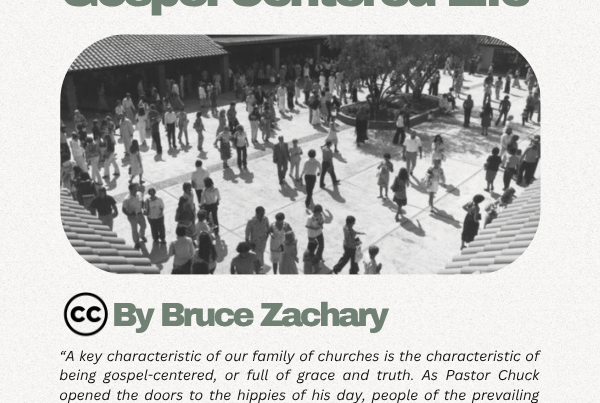
“Know When to Fold ‘em!”
Though I wouldn’t refer to myself as a mountain biker, I do own a nice bike and have ridden a few trails. In doing so I quickly learned a valuable trail-riding lesson that I’ve come to see as helpful in ministry too. Avoid ruts!
I’m sure that an avid off-road enthusiast would school me on how great it is to ride ruts, but wisdom and a bit of personal experience has taught me otherwise. One of the easiest things to do in church ministry is to just keep doing it the way you’ve always done it, especially if there appears to be any possible fruit associated with the task or event. But easiest is not always best, and if you ride the rut, you’re at its mercy.
While change for the sake of change is frivolous, objectively (and sometimes critically) evaluating the things we do as a church is essential. That being the case, I’ve told our ministry team several times, “the list of things that are immutable at Cross Connection is very small.” There are very few things we will not change, even if they appear—at first glance—to be fruitful. If there is no real or lasting fruit then it likely needs to go. But how do you know?
Start with Vision
In many ways, discerning what to do or not do as a church is simple, when you start with your purpose or vision. If you have no vision of who you are or why you exist as a church, then you will quickly succumb to ministry “congestion” and every new idea will end up being added to the ever-growing list of events, processes and ministries. But when you understand who you are, you can easily say “yes” or “no” when ideas end up on the table. You can be certain, if a senior executive brings a great new menu idea for a killer hamburger to CEO Dan Cathy of Chick-fil-A, it won’t go very far. In much the same way, at Cross Connection our vision—“life in connection with God, one another and the world, through Jesus”—helps us say “yes” or “no” all the time.
If the event doesn’t help us better connect with God, one another, or the world in some measurable way, then it probably won’t fit into our church for long. If the ministry isn’t helping the church to connect: with God through worship, one another in fellowship or the world evangelistically, then the ministry leadership is encouraged to tweak it or kill it.
Is it Fruitful?
“WAIT! What if the ministry or event is fruitful? You can’t just go around getting rid of important ministries?” I’ve heard it many times before, which is why it is important to objectively evaluate the effectiveness of your ministry efforts. The fact is, when inspected, many ministries are found to be leaf-laden, fruitless fig trees that need to be cursed. They look spectacular until you start moving the leaves around and looking for fruit. Often times in the process of inspection you will find that there is the potential for fruit if some hindrance is removed or sucker branch pruned. But you’ll never know if you never evaluate.
Golden Calves are Idols That Must Fall
“It sounds good in theory, but are you really serious about this? Do you really kill important ministries?” Yes!
About twelve years ago the previous leadership of our church set aside the mid-week Bible study to do home groups for a summer. We went from about seventy adults involved in the mid-week study to over 300 in home groups. At the time the leadership was not ready to do away with the mid-week completely. It took six more years and a change of senior leadership to make that change. While the mid-week was considered an essential item on our menu, it was ultimately a golden calf that needed to die. Now, more than a third of the church attends home groups that we call Connect Groups.
For more than twenty-five years our church held an annual Halloween alternative “Harvest Celebration.” Every October 31st more than 150 volunteers setup and ran an event that attracted over 1,250 visitors, and though it appeared successful there was no evidence of lasting fruit beyond the event itself. So, this last year it too found its way to the stone table. To be fair, we didn’t entirely kill it. Instead we split one big event at church into 10 “Neighborhood Harvest Parties” in the front yards of Connect Group host-homes and outreached to trick-or-treating families throughout our community.
Two Ways to Die
Ministry euthanasia is not easy and sometimes it’s outright arduous, but in time pruning produces greater fruit. Thus the question moves from “Should we?” to “How should we?” For us it has typically come down to one of two ways. We either deliver a decisive deathblow or we deprive it of oxygen.
Decisive action is the classic “ripping off the Band-Aid”, it’s quick, but it’s also much more noticeable and often a bit painful. The other method—“oxygen deprivation”—is usually as effective, but takes a bit longer and requires more finesse. I say “usually” because sometimes well-meaning emergency ministry technicians try to “resuscitate” the ministry you’re trying to kill, so you’ve got to be committed to the ministry DNR when you cut off its funding, promotion and all other life-sustaining measures.
Lead!
It may seem a bit coarse and insensitive (I’ve certainly been called worse). Leadership involves tough decisions that not everyone has the stomach for, and that is often the line between minimum and maximum fruitfulness. If you’re in church leadership there are times when you just need to lead, because the only difference between a rut and a grave is the depth.









